Approaches To Professional Nursing Practice
VerifiedAdded on 2022/09/18
|9
|1773
|21
AI Summary
Contribute Materials
Your contribution can guide someone’s learning journey. Share your
documents today.
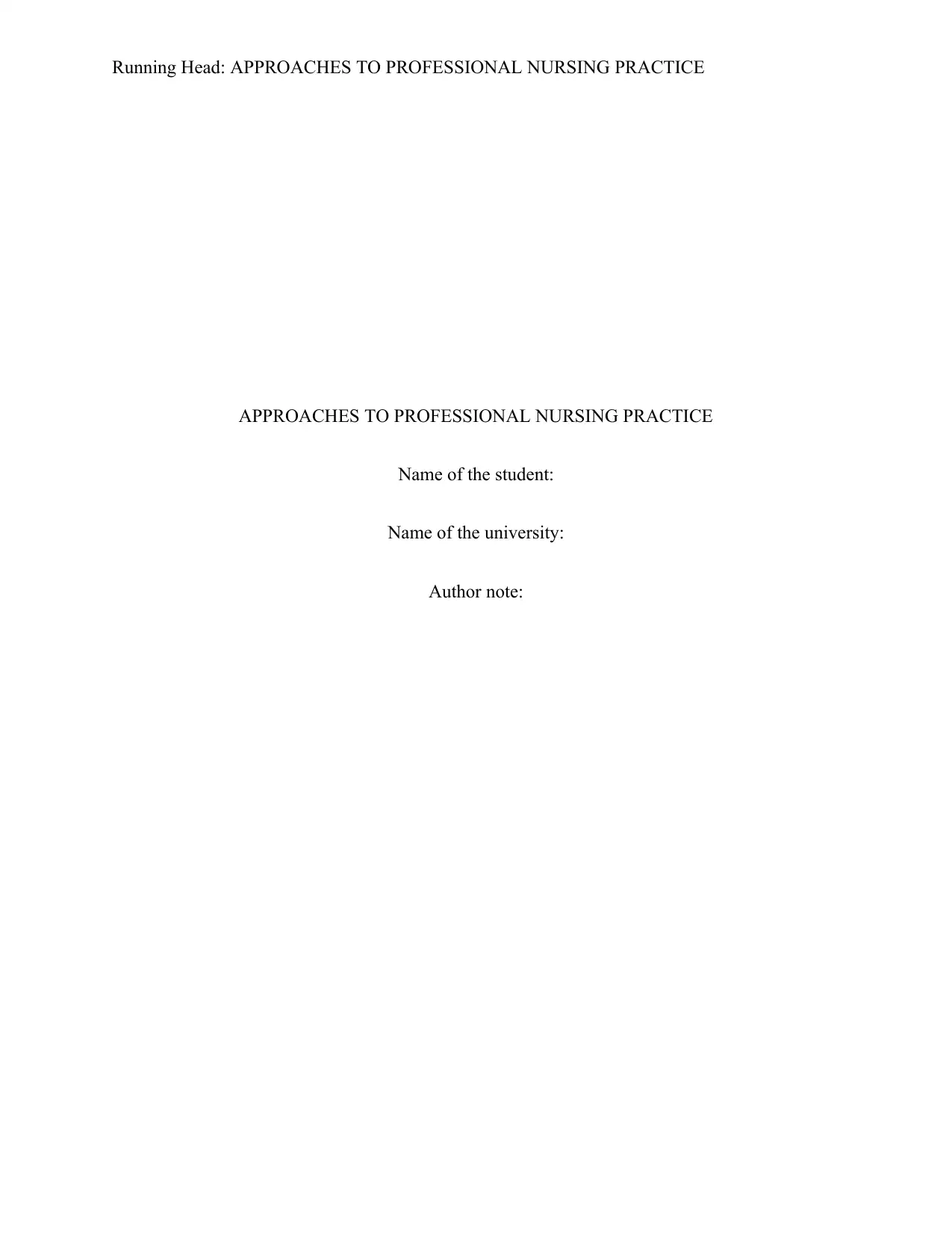
Running Head: APPROACHES TO PROFESSIONAL NURSING PRACTICE
APPROACHES TO PROFESSIONAL NURSING PRACTICE
Name of the student:
Name of the university:
Author note:
APPROACHES TO PROFESSIONAL NURSING PRACTICE
Name of the student:
Name of the university:
Author note:
Secure Best Marks with AI Grader
Need help grading? Try our AI Grader for instant feedback on your assignments.
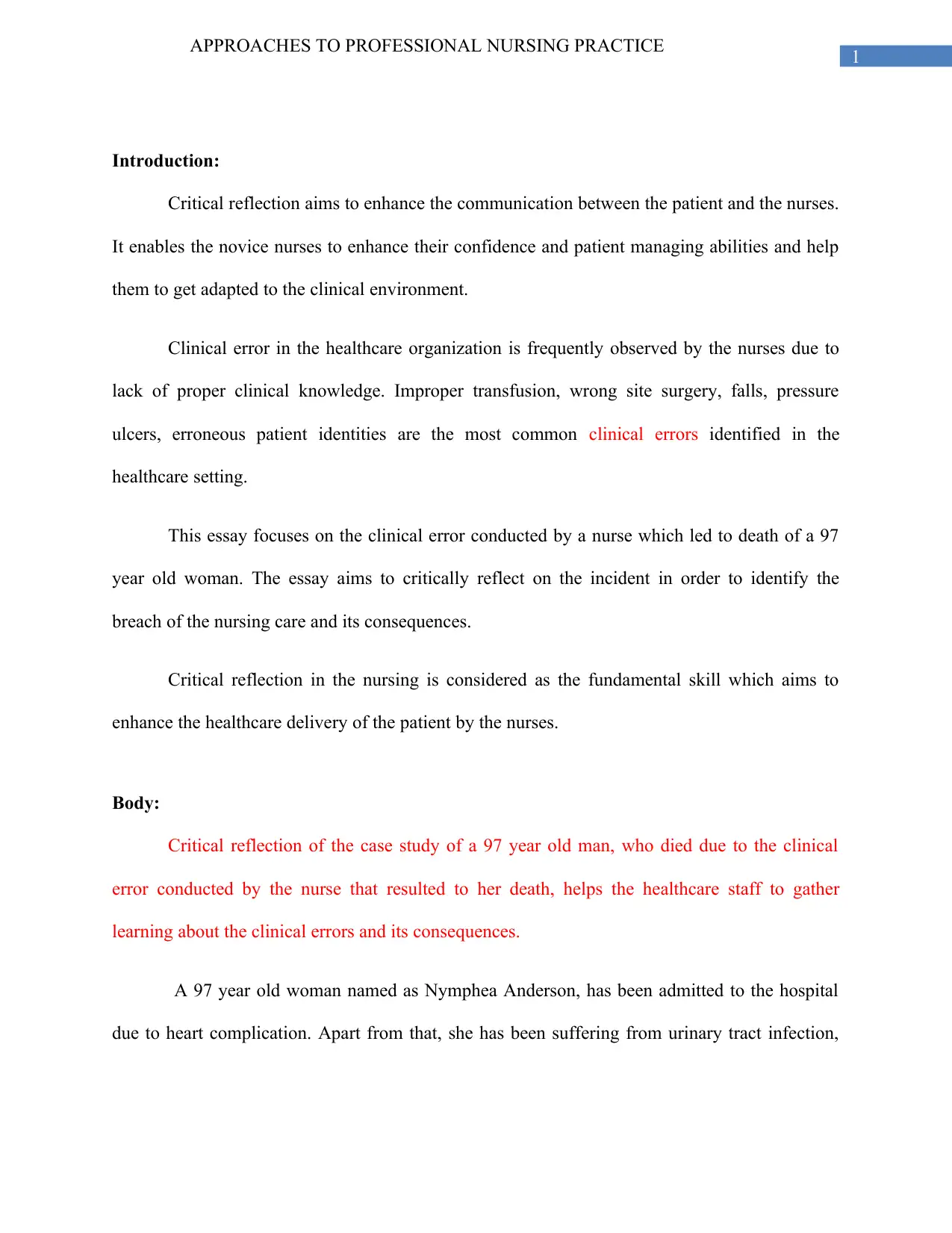
1
APPROACHES TO PROFESSIONAL NURSING PRACTICE
Introduction:
Critical reflection aims to enhance the communication between the patient and the nurses.
It enables the novice nurses to enhance their confidence and patient managing abilities and help
them to get adapted to the clinical environment.
Clinical error in the healthcare organization is frequently observed by the nurses due to
lack of proper clinical knowledge. Improper transfusion, wrong site surgery, falls, pressure
ulcers, erroneous patient identities are the most common clinical errors identified in the
healthcare setting.
This essay focuses on the clinical error conducted by a nurse which led to death of a 97
year old woman. The essay aims to critically reflect on the incident in order to identify the
breach of the nursing care and its consequences.
Critical reflection in the nursing is considered as the fundamental skill which aims to
enhance the healthcare delivery of the patient by the nurses.
Body:
Critical reflection of the case study of a 97 year old man, who died due to the clinical
error conducted by the nurse that resulted to her death, helps the healthcare staff to gather
learning about the clinical errors and its consequences.
A 97 year old woman named as Nymphea Anderson, has been admitted to the hospital
due to heart complication. Apart from that, she has been suffering from urinary tract infection,
APPROACHES TO PROFESSIONAL NURSING PRACTICE
Introduction:
Critical reflection aims to enhance the communication between the patient and the nurses.
It enables the novice nurses to enhance their confidence and patient managing abilities and help
them to get adapted to the clinical environment.
Clinical error in the healthcare organization is frequently observed by the nurses due to
lack of proper clinical knowledge. Improper transfusion, wrong site surgery, falls, pressure
ulcers, erroneous patient identities are the most common clinical errors identified in the
healthcare setting.
This essay focuses on the clinical error conducted by a nurse which led to death of a 97
year old woman. The essay aims to critically reflect on the incident in order to identify the
breach of the nursing care and its consequences.
Critical reflection in the nursing is considered as the fundamental skill which aims to
enhance the healthcare delivery of the patient by the nurses.
Body:
Critical reflection of the case study of a 97 year old man, who died due to the clinical
error conducted by the nurse that resulted to her death, helps the healthcare staff to gather
learning about the clinical errors and its consequences.
A 97 year old woman named as Nymphea Anderson, has been admitted to the hospital
due to heart complication. Apart from that, she has been suffering from urinary tract infection,
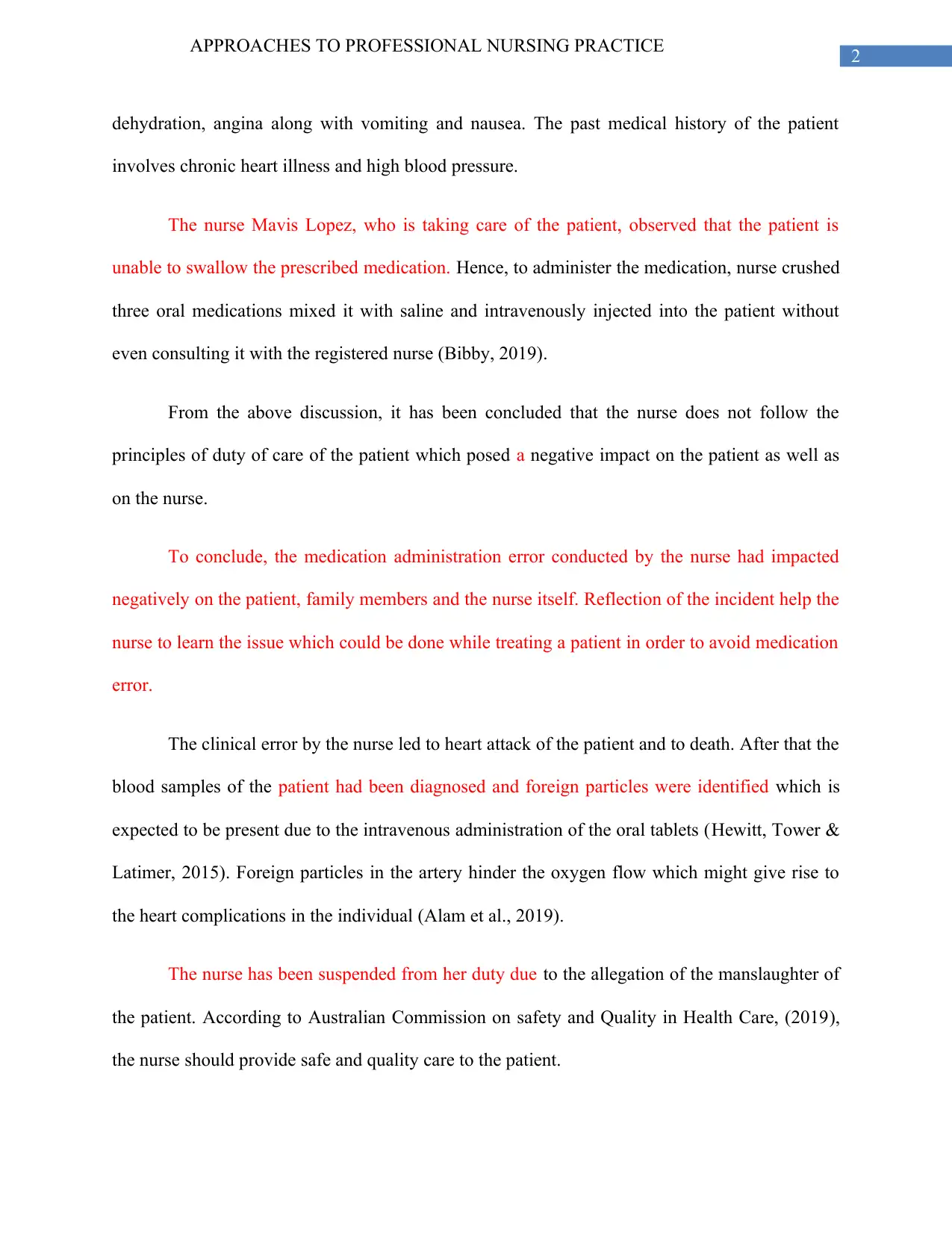
2
APPROACHES TO PROFESSIONAL NURSING PRACTICE
dehydration, angina along with vomiting and nausea. The past medical history of the patient
involves chronic heart illness and high blood pressure.
The nurse Mavis Lopez, who is taking care of the patient, observed that the patient is
unable to swallow the prescribed medication. Hence, to administer the medication, nurse crushed
three oral medications mixed it with saline and intravenously injected into the patient without
even consulting it with the registered nurse (Bibby, 2019).
From the above discussion, it has been concluded that the nurse does not follow the
principles of duty of care of the patient which posed a negative impact on the patient as well as
on the nurse.
To conclude, the medication administration error conducted by the nurse had impacted
negatively on the patient, family members and the nurse itself. Reflection of the incident help the
nurse to learn the issue which could be done while treating a patient in order to avoid medication
error.
The clinical error by the nurse led to heart attack of the patient and to death. After that the
blood samples of the patient had been diagnosed and foreign particles were identified which is
expected to be present due to the intravenous administration of the oral tablets (Hewitt, Tower &
Latimer, 2015). Foreign particles in the artery hinder the oxygen flow which might give rise to
the heart complications in the individual (Alam et al., 2019).
The nurse has been suspended from her duty due to the allegation of the manslaughter of
the patient. According to Australian Commission on safety and Quality in Health Care, (2019),
the nurse should provide safe and quality care to the patient.
APPROACHES TO PROFESSIONAL NURSING PRACTICE
dehydration, angina along with vomiting and nausea. The past medical history of the patient
involves chronic heart illness and high blood pressure.
The nurse Mavis Lopez, who is taking care of the patient, observed that the patient is
unable to swallow the prescribed medication. Hence, to administer the medication, nurse crushed
three oral medications mixed it with saline and intravenously injected into the patient without
even consulting it with the registered nurse (Bibby, 2019).
From the above discussion, it has been concluded that the nurse does not follow the
principles of duty of care of the patient which posed a negative impact on the patient as well as
on the nurse.
To conclude, the medication administration error conducted by the nurse had impacted
negatively on the patient, family members and the nurse itself. Reflection of the incident help the
nurse to learn the issue which could be done while treating a patient in order to avoid medication
error.
The clinical error by the nurse led to heart attack of the patient and to death. After that the
blood samples of the patient had been diagnosed and foreign particles were identified which is
expected to be present due to the intravenous administration of the oral tablets (Hewitt, Tower &
Latimer, 2015). Foreign particles in the artery hinder the oxygen flow which might give rise to
the heart complications in the individual (Alam et al., 2019).
The nurse has been suspended from her duty due to the allegation of the manslaughter of
the patient. According to Australian Commission on safety and Quality in Health Care, (2019),
the nurse should provide safe and quality care to the patient.
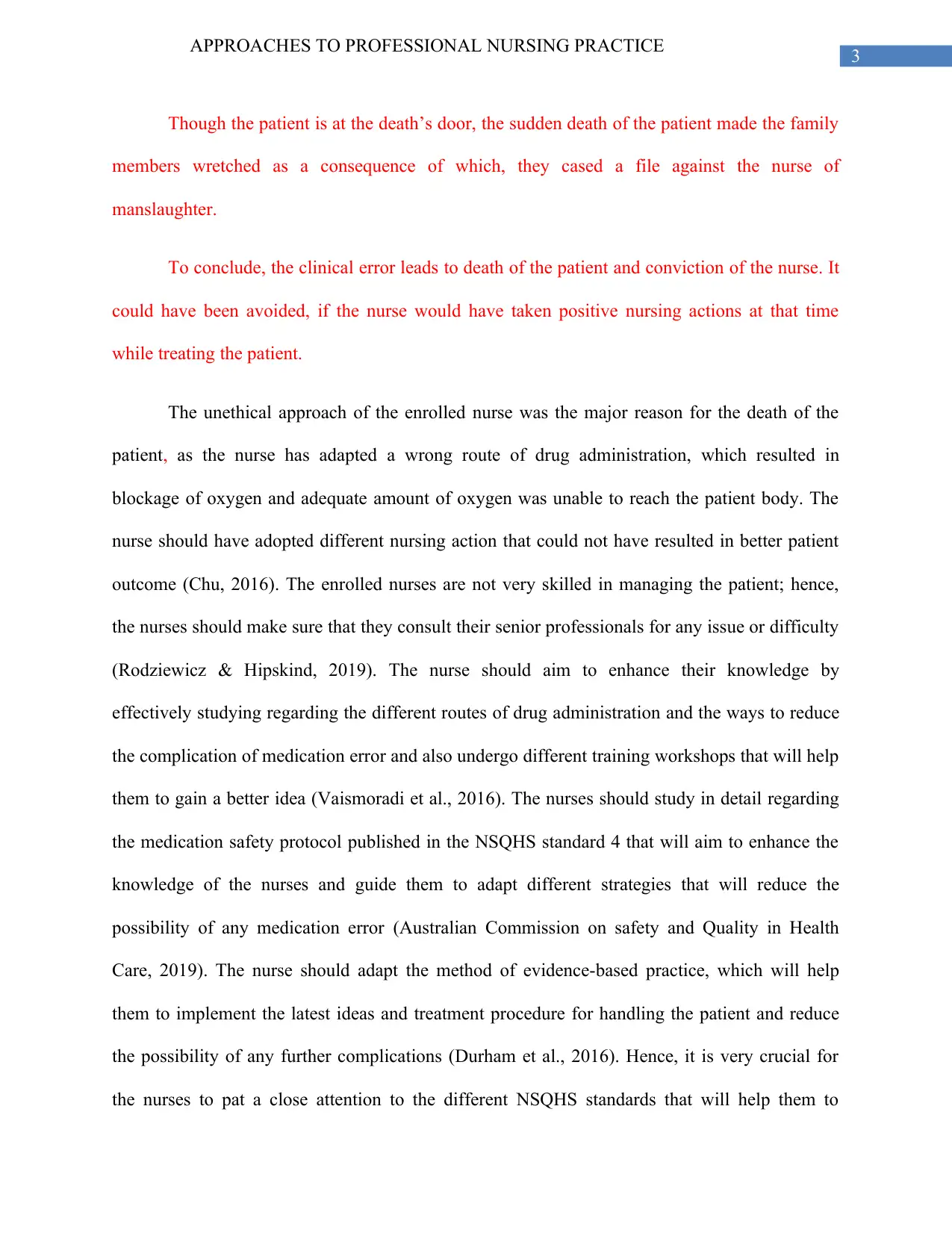
3
APPROACHES TO PROFESSIONAL NURSING PRACTICE
Though the patient is at the death’s door, the sudden death of the patient made the family
members wretched as a consequence of which, they cased a file against the nurse of
manslaughter.
To conclude, the clinical error leads to death of the patient and conviction of the nurse. It
could have been avoided, if the nurse would have taken positive nursing actions at that time
while treating the patient.
The unethical approach of the enrolled nurse was the major reason for the death of the
patient, as the nurse has adapted a wrong route of drug administration, which resulted in
blockage of oxygen and adequate amount of oxygen was unable to reach the patient body. The
nurse should have adopted different nursing action that could not have resulted in better patient
outcome (Chu, 2016). The enrolled nurses are not very skilled in managing the patient; hence,
the nurses should make sure that they consult their senior professionals for any issue or difficulty
(Rodziewicz & Hipskind, 2019). The nurse should aim to enhance their knowledge by
effectively studying regarding the different routes of drug administration and the ways to reduce
the complication of medication error and also undergo different training workshops that will help
them to gain a better idea (Vaismoradi et al., 2016). The nurses should study in detail regarding
the medication safety protocol published in the NSQHS standard 4 that will aim to enhance the
knowledge of the nurses and guide them to adapt different strategies that will reduce the
possibility of any medication error (Australian Commission on safety and Quality in Health
Care, 2019). The nurse should adapt the method of evidence-based practice, which will help
them to implement the latest ideas and treatment procedure for handling the patient and reduce
the possibility of any further complications (Durham et al., 2016). Hence, it is very crucial for
the nurses to pat a close attention to the different NSQHS standards that will help them to
APPROACHES TO PROFESSIONAL NURSING PRACTICE
Though the patient is at the death’s door, the sudden death of the patient made the family
members wretched as a consequence of which, they cased a file against the nurse of
manslaughter.
To conclude, the clinical error leads to death of the patient and conviction of the nurse. It
could have been avoided, if the nurse would have taken positive nursing actions at that time
while treating the patient.
The unethical approach of the enrolled nurse was the major reason for the death of the
patient, as the nurse has adapted a wrong route of drug administration, which resulted in
blockage of oxygen and adequate amount of oxygen was unable to reach the patient body. The
nurse should have adopted different nursing action that could not have resulted in better patient
outcome (Chu, 2016). The enrolled nurses are not very skilled in managing the patient; hence,
the nurses should make sure that they consult their senior professionals for any issue or difficulty
(Rodziewicz & Hipskind, 2019). The nurse should aim to enhance their knowledge by
effectively studying regarding the different routes of drug administration and the ways to reduce
the complication of medication error and also undergo different training workshops that will help
them to gain a better idea (Vaismoradi et al., 2016). The nurses should study in detail regarding
the medication safety protocol published in the NSQHS standard 4 that will aim to enhance the
knowledge of the nurses and guide them to adapt different strategies that will reduce the
possibility of any medication error (Australian Commission on safety and Quality in Health
Care, 2019). The nurse should adapt the method of evidence-based practice, which will help
them to implement the latest ideas and treatment procedure for handling the patient and reduce
the possibility of any further complications (Durham et al., 2016). Hence, it is very crucial for
the nurses to pat a close attention to the different NSQHS standards that will help them to
Secure Best Marks with AI Grader
Need help grading? Try our AI Grader for instant feedback on your assignments.
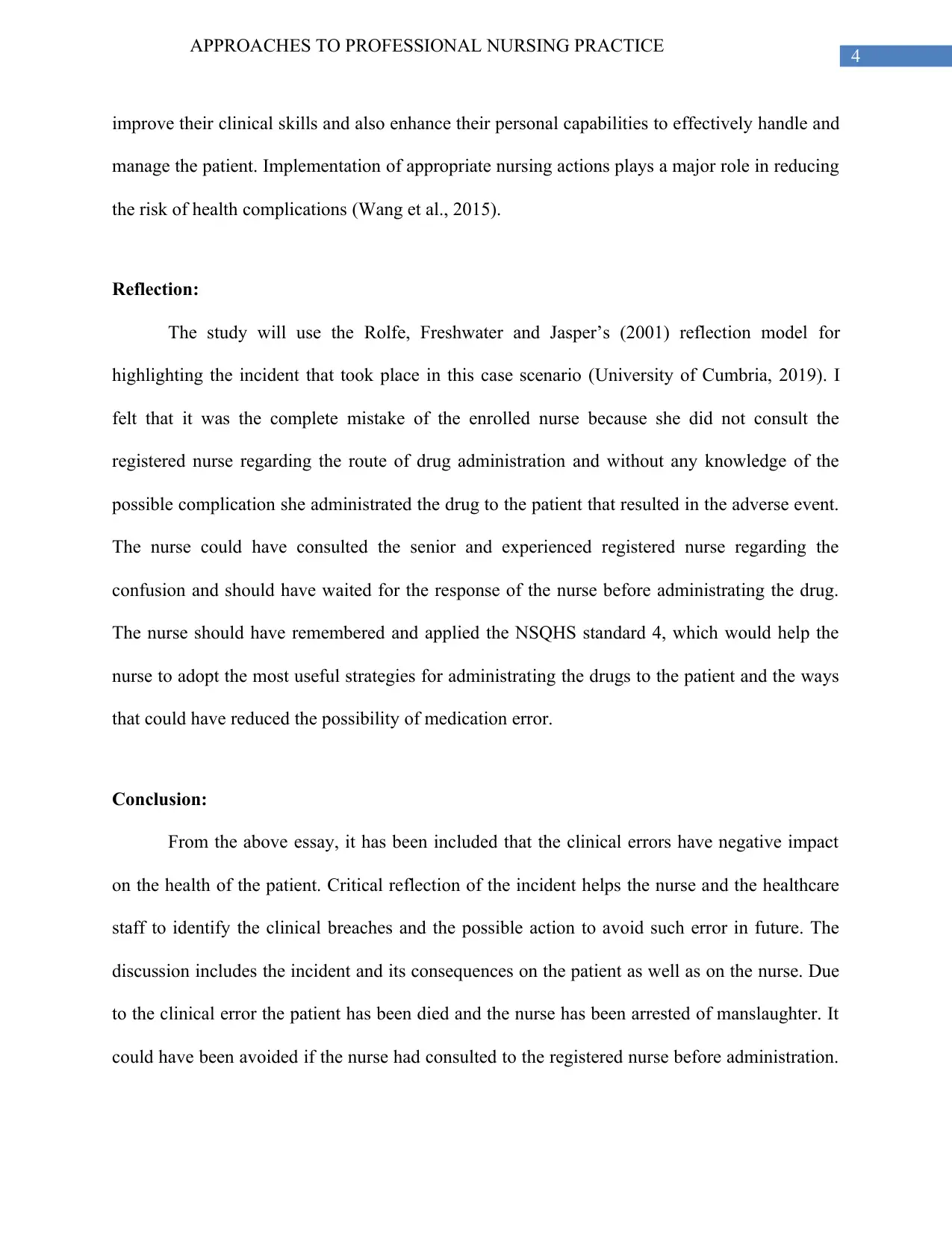
4
APPROACHES TO PROFESSIONAL NURSING PRACTICE
improve their clinical skills and also enhance their personal capabilities to effectively handle and
manage the patient. Implementation of appropriate nursing actions plays a major role in reducing
the risk of health complications (Wang et al., 2015).
Reflection:
The study will use the Rolfe, Freshwater and Jasper’s (2001) reflection model for
highlighting the incident that took place in this case scenario (University of Cumbria, 2019). I
felt that it was the complete mistake of the enrolled nurse because she did not consult the
registered nurse regarding the route of drug administration and without any knowledge of the
possible complication she administrated the drug to the patient that resulted in the adverse event.
The nurse could have consulted the senior and experienced registered nurse regarding the
confusion and should have waited for the response of the nurse before administrating the drug.
The nurse should have remembered and applied the NSQHS standard 4, which would help the
nurse to adopt the most useful strategies for administrating the drugs to the patient and the ways
that could have reduced the possibility of medication error.
Conclusion:
From the above essay, it has been included that the clinical errors have negative impact
on the health of the patient. Critical reflection of the incident helps the nurse and the healthcare
staff to identify the clinical breaches and the possible action to avoid such error in future. The
discussion includes the incident and its consequences on the patient as well as on the nurse. Due
to the clinical error the patient has been died and the nurse has been arrested of manslaughter. It
could have been avoided if the nurse had consulted to the registered nurse before administration.
APPROACHES TO PROFESSIONAL NURSING PRACTICE
improve their clinical skills and also enhance their personal capabilities to effectively handle and
manage the patient. Implementation of appropriate nursing actions plays a major role in reducing
the risk of health complications (Wang et al., 2015).
Reflection:
The study will use the Rolfe, Freshwater and Jasper’s (2001) reflection model for
highlighting the incident that took place in this case scenario (University of Cumbria, 2019). I
felt that it was the complete mistake of the enrolled nurse because she did not consult the
registered nurse regarding the route of drug administration and without any knowledge of the
possible complication she administrated the drug to the patient that resulted in the adverse event.
The nurse could have consulted the senior and experienced registered nurse regarding the
confusion and should have waited for the response of the nurse before administrating the drug.
The nurse should have remembered and applied the NSQHS standard 4, which would help the
nurse to adopt the most useful strategies for administrating the drugs to the patient and the ways
that could have reduced the possibility of medication error.
Conclusion:
From the above essay, it has been included that the clinical errors have negative impact
on the health of the patient. Critical reflection of the incident helps the nurse and the healthcare
staff to identify the clinical breaches and the possible action to avoid such error in future. The
discussion includes the incident and its consequences on the patient as well as on the nurse. Due
to the clinical error the patient has been died and the nurse has been arrested of manslaughter. It
could have been avoided if the nurse had consulted to the registered nurse before administration.
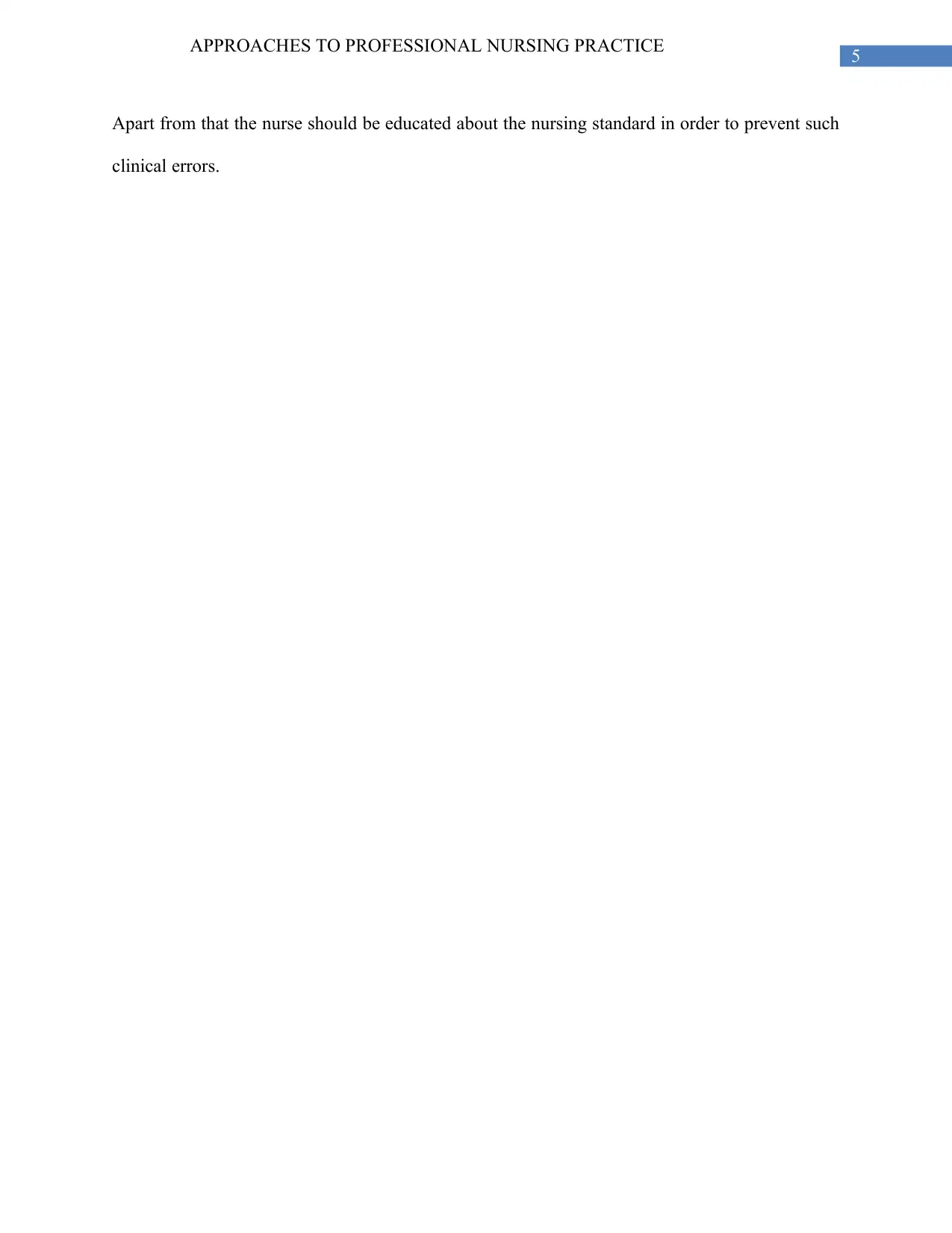
5
APPROACHES TO PROFESSIONAL NURSING PRACTICE
Apart from that the nurse should be educated about the nursing standard in order to prevent such
clinical errors.
APPROACHES TO PROFESSIONAL NURSING PRACTICE
Apart from that the nurse should be educated about the nursing standard in order to prevent such
clinical errors.
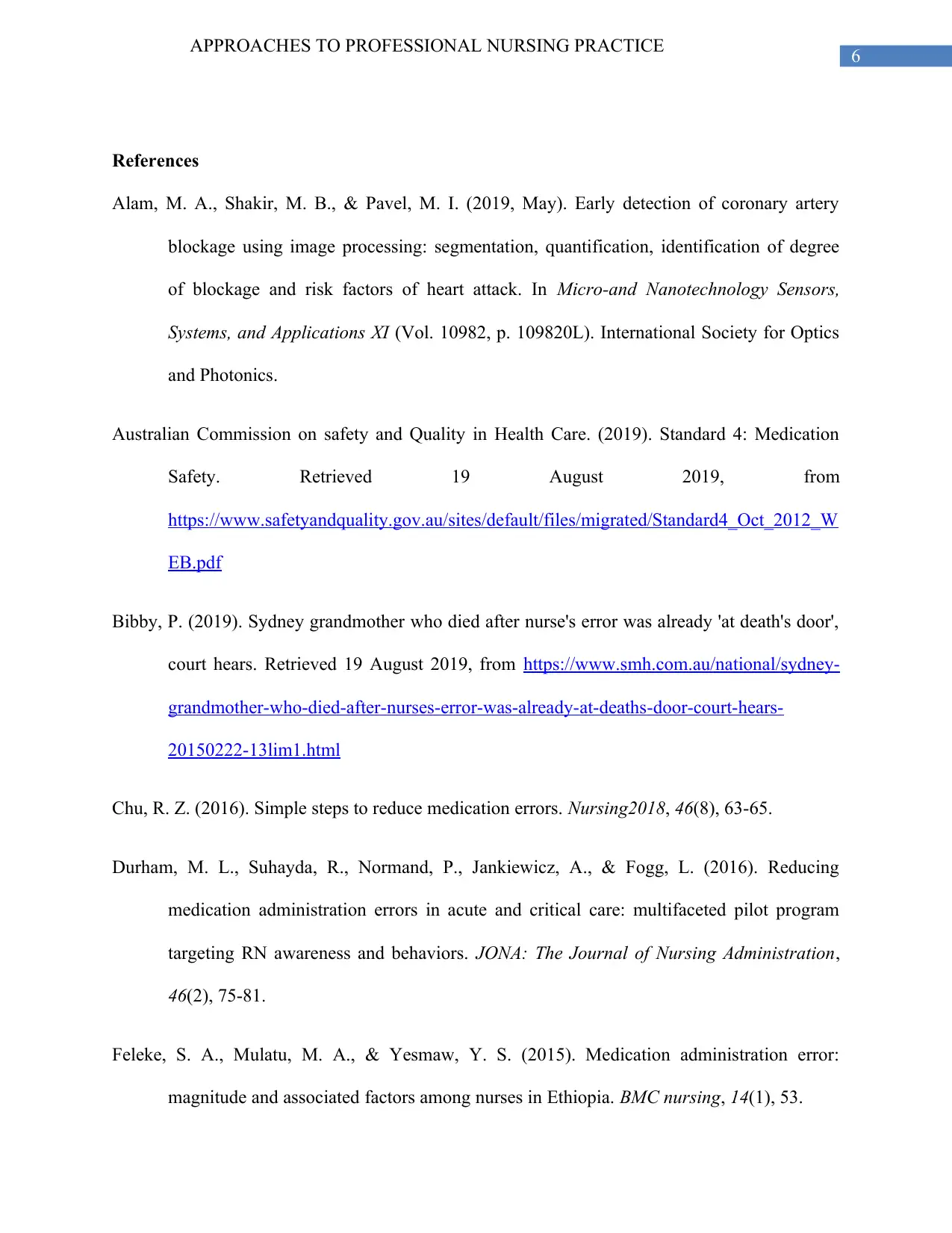
6
APPROACHES TO PROFESSIONAL NURSING PRACTICE
References
Alam, M. A., Shakir, M. B., & Pavel, M. I. (2019, May). Early detection of coronary artery
blockage using image processing: segmentation, quantification, identification of degree
of blockage and risk factors of heart attack. In Micro-and Nanotechnology Sensors,
Systems, and Applications XI (Vol. 10982, p. 109820L). International Society for Optics
and Photonics.
Australian Commission on safety and Quality in Health Care. (2019). Standard 4: Medication
Safety. Retrieved 19 August 2019, from
https://www.safetyandquality.gov.au/sites/default/files/migrated/Standard4_Oct_2012_W
EB.pdf
Bibby, P. (2019). Sydney grandmother who died after nurse's error was already 'at death's door',
court hears. Retrieved 19 August 2019, from https://www.smh.com.au/national/sydney-
grandmother-who-died-after-nurses-error-was-already-at-deaths-door-court-hears-
20150222-13lim1.html
Chu, R. Z. (2016). Simple steps to reduce medication errors. Nursing2018, 46(8), 63-65.
Durham, M. L., Suhayda, R., Normand, P., Jankiewicz, A., & Fogg, L. (2016). Reducing
medication administration errors in acute and critical care: multifaceted pilot program
targeting RN awareness and behaviors. JONA: The Journal of Nursing Administration,
46(2), 75-81.
Feleke, S. A., Mulatu, M. A., & Yesmaw, Y. S. (2015). Medication administration error:
magnitude and associated factors among nurses in Ethiopia. BMC nursing, 14(1), 53.
APPROACHES TO PROFESSIONAL NURSING PRACTICE
References
Alam, M. A., Shakir, M. B., & Pavel, M. I. (2019, May). Early detection of coronary artery
blockage using image processing: segmentation, quantification, identification of degree
of blockage and risk factors of heart attack. In Micro-and Nanotechnology Sensors,
Systems, and Applications XI (Vol. 10982, p. 109820L). International Society for Optics
and Photonics.
Australian Commission on safety and Quality in Health Care. (2019). Standard 4: Medication
Safety. Retrieved 19 August 2019, from
https://www.safetyandquality.gov.au/sites/default/files/migrated/Standard4_Oct_2012_W
EB.pdf
Bibby, P. (2019). Sydney grandmother who died after nurse's error was already 'at death's door',
court hears. Retrieved 19 August 2019, from https://www.smh.com.au/national/sydney-
grandmother-who-died-after-nurses-error-was-already-at-deaths-door-court-hears-
20150222-13lim1.html
Chu, R. Z. (2016). Simple steps to reduce medication errors. Nursing2018, 46(8), 63-65.
Durham, M. L., Suhayda, R., Normand, P., Jankiewicz, A., & Fogg, L. (2016). Reducing
medication administration errors in acute and critical care: multifaceted pilot program
targeting RN awareness and behaviors. JONA: The Journal of Nursing Administration,
46(2), 75-81.
Feleke, S. A., Mulatu, M. A., & Yesmaw, Y. S. (2015). Medication administration error:
magnitude and associated factors among nurses in Ethiopia. BMC nursing, 14(1), 53.
Paraphrase This Document
Need a fresh take? Get an instant paraphrase of this document with our AI Paraphraser
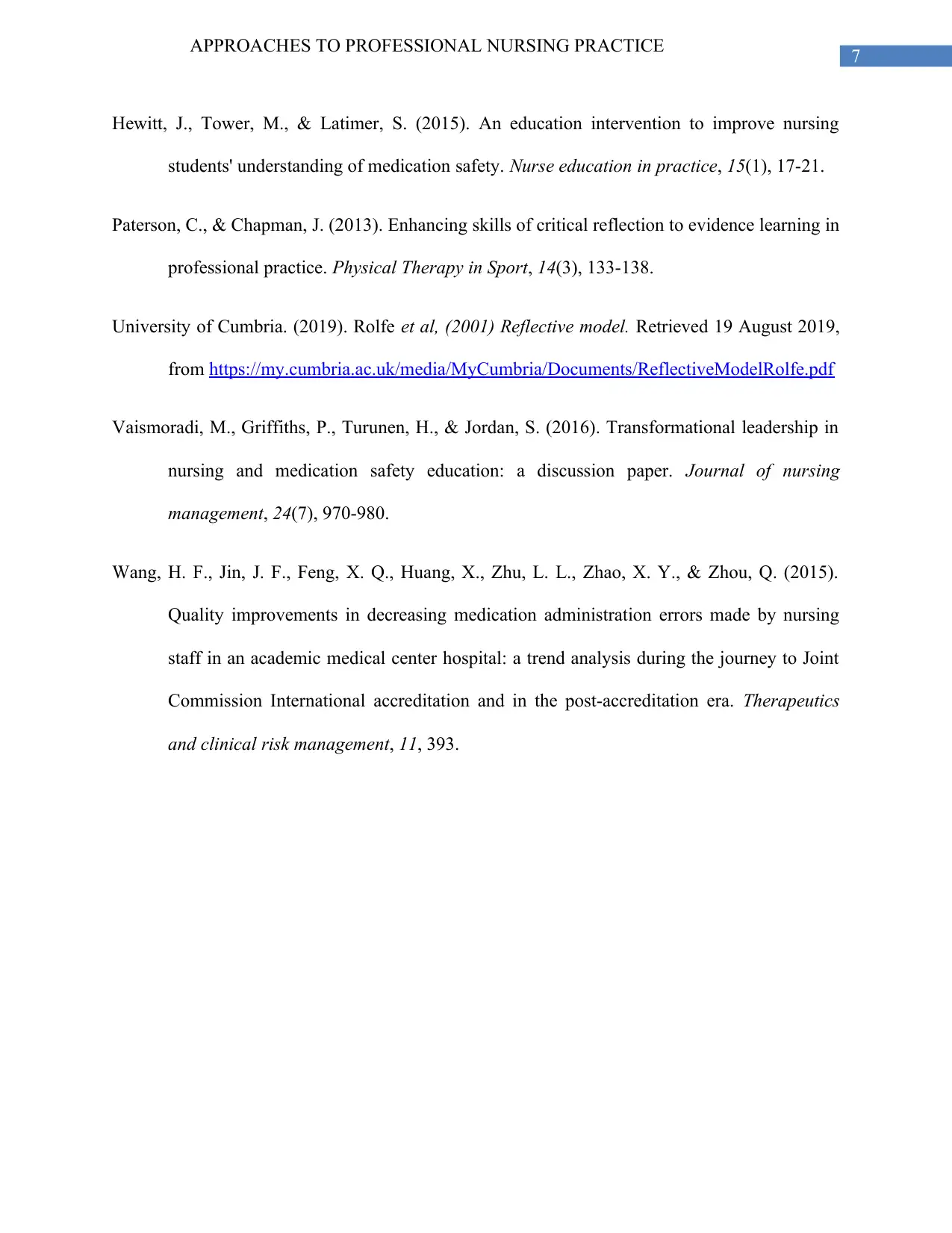
7
APPROACHES TO PROFESSIONAL NURSING PRACTICE
Hewitt, J., Tower, M., & Latimer, S. (2015). An education intervention to improve nursing
students' understanding of medication safety. Nurse education in practice, 15(1), 17-21.
Paterson, C., & Chapman, J. (2013). Enhancing skills of critical reflection to evidence learning in
professional practice. Physical Therapy in Sport, 14(3), 133-138.
University of Cumbria. (2019). Rolfe et al, (2001) Reflective model. Retrieved 19 August 2019,
from https://my.cumbria.ac.uk/media/MyCumbria/Documents/ReflectiveModelRolfe.pdf
Vaismoradi, M., Griffiths, P., Turunen, H., & Jordan, S. (2016). Transformational leadership in
nursing and medication safety education: a discussion paper. Journal of nursing
management, 24(7), 970-980.
Wang, H. F., Jin, J. F., Feng, X. Q., Huang, X., Zhu, L. L., Zhao, X. Y., & Zhou, Q. (2015).
Quality improvements in decreasing medication administration errors made by nursing
staff in an academic medical center hospital: a trend analysis during the journey to Joint
Commission International accreditation and in the post-accreditation era. Therapeutics
and clinical risk management, 11, 393.
APPROACHES TO PROFESSIONAL NURSING PRACTICE
Hewitt, J., Tower, M., & Latimer, S. (2015). An education intervention to improve nursing
students' understanding of medication safety. Nurse education in practice, 15(1), 17-21.
Paterson, C., & Chapman, J. (2013). Enhancing skills of critical reflection to evidence learning in
professional practice. Physical Therapy in Sport, 14(3), 133-138.
University of Cumbria. (2019). Rolfe et al, (2001) Reflective model. Retrieved 19 August 2019,
from https://my.cumbria.ac.uk/media/MyCumbria/Documents/ReflectiveModelRolfe.pdf
Vaismoradi, M., Griffiths, P., Turunen, H., & Jordan, S. (2016). Transformational leadership in
nursing and medication safety education: a discussion paper. Journal of nursing
management, 24(7), 970-980.
Wang, H. F., Jin, J. F., Feng, X. Q., Huang, X., Zhu, L. L., Zhao, X. Y., & Zhou, Q. (2015).
Quality improvements in decreasing medication administration errors made by nursing
staff in an academic medical center hospital: a trend analysis during the journey to Joint
Commission International accreditation and in the post-accreditation era. Therapeutics
and clinical risk management, 11, 393.
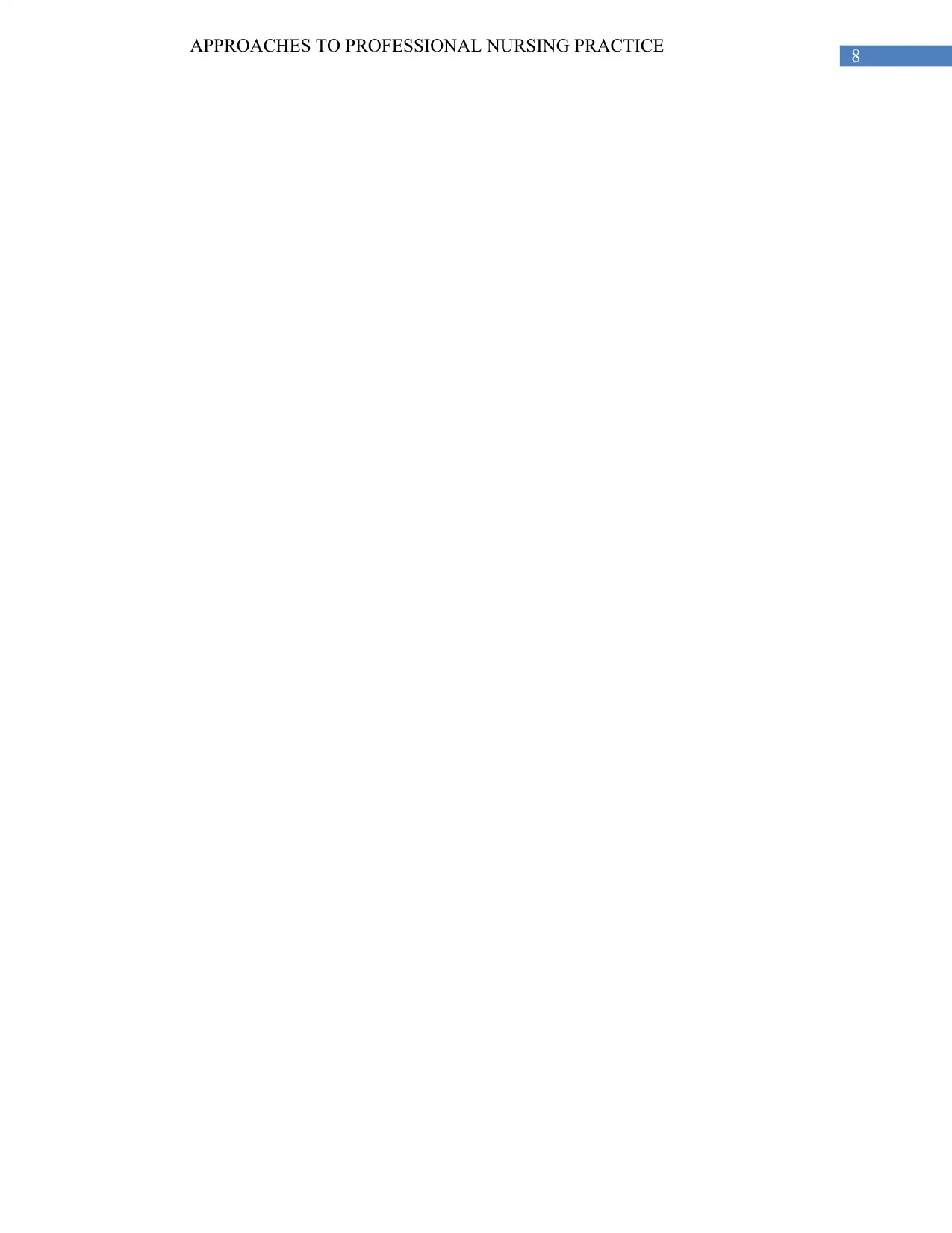
8
APPROACHES TO PROFESSIONAL NURSING PRACTICE
APPROACHES TO PROFESSIONAL NURSING PRACTICE
1 out of 9
Related Documents
Your All-in-One AI-Powered Toolkit for Academic Success.
+13062052269
info@desklib.com
Available 24*7 on WhatsApp / Email
![[object Object]](/_next/static/media/star-bottom.7253800d.svg)
Unlock your academic potential
© 2024 | Zucol Services PVT LTD | All rights reserved.





